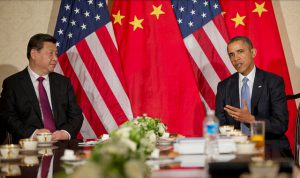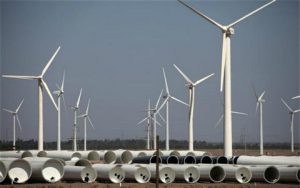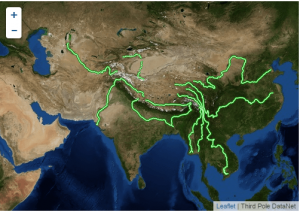In the lead up to this week’s APEC summit in Beijing, there was hope among environmentalists that China and the US would agree a significant deal on climate change – one area where the fraught bilateral relationship is comparatively smooth. And indeed both sides today made major announcements: Barack Obama pledged that the US would cut greenhouse-gas emissions between 26-28% below 2005 levels by 2025, while Xi Jinping set targets to peak carbon-dioxide emissions around 2030 and to boost China’s share of non-fossil fuel energy to around 20% by the same year.
But, beyond the diplomatic success, how significant are these figures? Only last week, climate scientist Kevin Anderson told chinadialogue that China needed to peak emissions by the mid 2020s to give the world a “reasonable” chance of staying within 2C of warming and avoiding dangerous climate change. The US meanwhile must have "eliminated fossil fuel use from their energy system early in the 2030s", he said. We’ve been gathering reaction from around the world, and will continue update this as more comes in:
Li Junfeng, Director General of the NDRC’s National Climate Change Center:
This agreement is neither a commitment to China by the US, nor a commitment to the US by China, as it has no binding force. Its significance is more symbolic than practical.
For the US it will not be very hard to reach the target Obama announced, of a 26%-28% emissions cut. The US is due to see a 17% cut by 2020, leaving only 10% percentage points left to go. The main uncertainty for the US is Congress, and I hear some members have already spoken out in opposition to the deal.
China will find it more difficult to reach the target Xi Jinping has proposed. Non-fossil sources of energy only account for 10% of the total energy mix currently, and China’s energy transition is not yet guaranteed. But the target has undoubtedly been given careful consideration: back at the New York climate summit in September Vice-Premier Zhang Gaoli said that China would do its best to achieve peak carbon as early as possible.
This joint statement makes things clearer for the 2015 UN climate summit in Paris. The EU has made its commitment to emissions cuts, and now China and the US have made a similar statement. The efforts everyone will be making to cut emissions are now out in the open.
Guan Dabo, professor in climate change and international development, University of East Anglia:
The joint commitments to curb carbon emissions by China and the US are a good start for a possible global deal in Paris next year. The most important and positive part is that such a pledge renews the hope for a global climate-change mitigation agreement in the post-Kyoto era. The US has chosen to be back where it stood in 1997. Since America’s annual carbon emissions have kept almost constant (with a slight decrease during the recession) at 6,000 million tonnes per year over the last decade, a 26%-28% of reduction by 2025 is easy to achieve in the next 10 years. It sets an example for other developed countries, namely Japan, Australia and Canada, who have not shown themselves motivated to cut emissions in recent years.
But is not ambitious enough. I would welcome a stronger commitment in Paris. Such efforts from the developed world will help, but will not be sufficient to meet the 2 degree target. And without substantial emission reduction in the global south, a 2 degree target will be hopeless.
China plans to peak at 2030 and extend its zero emission energy sources targets from 15% in 2020 to 20% in 2030. This can only be a part of its overall commitment for curbing CO2 emissions. Chinese emissions will be about three times the US level in 2030. China’s efforts will therefore determine the outcome of global climate-change mitigation. I also hope to see a more ambitious plan announced by China in Paris. Indeed, China can afford to set a cap for emissions, at least in wealthy cities like Beijing and Shanghai and coastal provinces. China has undergone an experiment in emission trading in seven provinces, which can pave the pathway for a national emission cap in the near future.
An emission peak in China is not the end of climate change mitigation, but only the start. The most important and challenging task will be working out how to prevent further emission leakages from China to other global south countries. Our planet cannot afford to have another emission giant, such as India, Latin American or Africa, and to wait another 20-30 years for it to peak. Equal and fair access to green technologies, global emission control policies and economic mechanisms as well as sustainable consumption will be crucial.
Joanna Lewis, associate professor, Georgetown University:
The joint climate announcement by the United States and China could mark a turning point in bilateral relations, and is certainly a sign that climate has become the cornerstone issue of US-China cooperation. China’s announcement that its emissions will peak by 2030 or earlier is on the earlier side of when recent modelling studies out of both the US and China have demonstrated that an emissions peak could occur. If you review recent studies by Chinese and US researchers, their baseline scenarios put a CO2 peak year in the 2035-2040 timeframe, and their most ambitious scenarios in the 2025-2030 timeframe. Therefore the announcement of a peak year of 2030 or earlier would fall into the ambitious range.
Achieving an emissions peak is dependent on coal use also peaking likely several years in advance of any CO2 peak, which will be extremely difficult for China to achieve. While there are signs of declining rates of coal use for the first time in decades, a shift away from coal in China will require even more aggressive programs to deploy low-carbon sources of energy, and to make energy use far more efficient. Also important will be the actual level at which China’s emissions peak, since this has major implications for the trajectory of total global emissions.
Of the new bilateral clean energy announcements released today, the extension and expansion of the US-China Clean Energy Research Center (CERC) is great news, since the CERC is arguably the most expansive bilateral cooperation initiative to date, and it has been making considerable progress in facilitating joint R&D while protecting the IPR involved. In addition, the initiative to launch a large-scale geologic carbon-sequestration project in China could be a huge step towards commercialising carbon capture and storage technologies.
Li Shuo, climate campaigner, Greenpeace China:
From a political and diplomatic perspective, this is very important and positive signal from two major leaders in the world. They are doing this ahead of the UN timetable and it’s always good to have big emitters providing clarity on their emissions. For us, this is really game-changing. What they put on paper today, I have the confidence they will deliver, not only because we see on the same paper the names of Obama and Xi Jinping but also because on the China side we already have coal consumption going down in absolute terms. That really inspires confidence – if that’s already happening in 2014, how much more might we hope for?
But these targets should be the floor rather than the ceiling of ambition. We would call for China to peak much earlier than 2030.
Under the UN timetable, countries are due to put forward their “intended nationally determined contributions” towards the 2 degree target by March next year. What we see from the US today is likely to be the main component of their offer. But for China the most important thing we are expecting is a specific CO2 emissions target. There are a few questions here. Question A is whether that’s going to be an absolute target, and I have a pretty high level of confidence that it will be – they have already set a peak year and you have to do calculations on absolute targets to get that. And Question B is the timetable of that target – whether it will be for 2025 or 2030, or a combination of the two. We think a shorter commitment period from 2020 to 2025 will prevent us from locking in low ambition. Lima will be a critical conference for us to reach that agreement.
Sam Geall, research fellow at University of Sussex and chinadialogue’s executive editor:
Today’s US-China joint announcement on climate will not only attract praise for its ambition, but also some recurring questions – not least about China’s record of transparency on its emissions. Recognising this, it’s a discouraging signal that during the APEC Summit in Beijing, the US Embassy’s air quality readings in the capital have been censored. Data quality has long been a controversial issue in China, where researchers recently calculated that air pollution caused 670,000 deaths in 2012.
China has shown admirable commitment to low-carbon development in its national plans, targets and policies, but an official culture of secrecy remains one of the major domestic constraints on its capacity to enforce and implement such regulations at a local level. Thanks to sustained pressure from concerned residents, China has seen encouraging breakthroughs in the realtime disclosure of environmental information, it would be a shame if China were to pollute this legacy with a needlessly censorious response to citizens’ demands for accurate information about the environment.
Andrew Steer, president, World Resources Institute:
It’s a new day to have the leaders of the US and China stand shoulder-to-shoulder and make significant commitments to curb their country’s emissions. They have both clearly acknowledged the mounting threat of climate change and the urgency of action. It’s heartening to see this level of cooperation, with climate change at the top of the agenda for the world’s top emitters.
The US and China should be commended for putting their initial pledges on the table so early. This should inject a jolt of momentum in the lead up to a global climate agreement in Paris.
The US target shows a serious commitment to action and puts the US on a path to reduce its emissions around 80% by mid-century. This pledge is grounded in what is achievable under existing US law. However, we should not underestimate the potential of innovation and technology to bring down costs and make it easier to meet — or even exceed — the proposed targets.
China’s pledge to increase non-fossil fuel energy and peak emissions around 2030 as early as possible is a major development — and reflects a shift in its position from just a few years ago. But it will be very important to see at what level and what year their emissions peak. Analysis shows that China’s emissions should peak before 2030 to limit the worst consequences of climate change.
Li Rusong, China Program Director at the Carbon Disclosure Project
The emissions targets in this China-US joint statement are realistic and feasible. China already has its own intrinsic reasons for reducing pollution and changing the energy mix. But to achieve these targets China and the US will need to bolster innovation in both technology and management, and that will be the technical obstacle.
Hu Min, Program Director of the Low-Carbon Development Program at Energy Foundation China
The China-US joint statement can be described as a breakthough on climate change and one that lays a solid foundation for a global emissions deal. It’s extremely encouraging that both nations have set clear emissions targets – in particular that China has, for the first time ever, officially given a timetable for reaching a peak in carbon emissions.
It’s very hard to say whether or not the US will achieve the target Obama set: when it comes to legislation there will be huge opposition from Congress. But in implementation, the energy and commerce departments will be able to act – if they have the personnel and financial support. China’s aim of increasing renewables to 20% of the energy mix will not be easily achieved, but at a stretch it can be done.
The US Secretary of Energy and Secretary of Commerce are due to visit China in April 2015, and I’m very much looking forward to that. It may mark a real start to China-US technology cooperation, in particular on smart and low-carbon cities, which are set to be a highlight of bilateral cooperation.
Jost Wuebbeke, Research Associate, Mercator Institute for China Studies (MERICS)
“If these are the cards the two are going to play in the coming climate talks, it will be impossible to effectively mitigate dangerous climate change and the future impacts China itself faces. China’s ambiguous announcement that emissions will peak until 2030 amounts to almost nothing as long as the size of the peak and the path of reduction remain unclear. This is especially unsatisfactory since Chinese domestic efforts would allow for more: the growth of coal consumption is slowing down quicker than expected and renewable energies develop faster than the government planned.
"The Chinese target bodes ill for the negotiations in Paris in 2015. If China sticks to the “peak until 2030 latest” formula, the country would be rather unlikely to accept a binding target for the coming decade which prescribes an absolute emission reduction. Securing diplomatic support from the US for this weak target could possibly even decrease China’s willingness to concede a more ambitious emission path during the negotiations. If China wants to be a leader for climate action, it will have to do better than that."
Wang Tao, Carnegie-Tsinghua Center for Global Policy
"It’s not that surprising that they gave this goal, but what surprised me is that they are willing to give this target before the official commitment deadline for Paris. I think that this could create good momentum, because last month the EU has come out with their target, and the US has now announced a target, and China has also come out with its target. So that’s the three big emitters all making their commitments.
"The renewable energy target announced today is 20% of non-fossil fuel in total energy consumption by 2030. As China planned to reach 15% of this by 2020, announced in 2012. So there is only 5% increase in the ten years between 2020 and 2030, which is slower than the growth rate before. Of course given the increasing energy consumption over time, the same percentage increase means more absolute capacity addition from renewable, but I still believe that with China’s strong commitments to both wind and PV development that we saw in the last two Five Year Plans, and the government’s support to develop global leading low carbon industries, this target could be higher by 2030."







